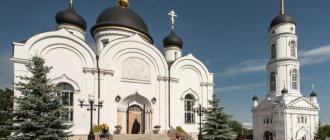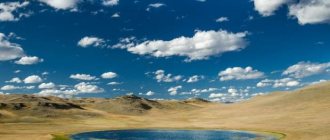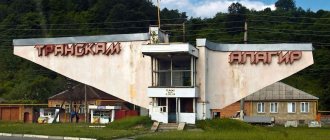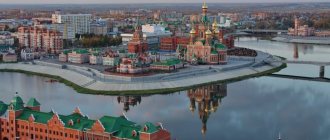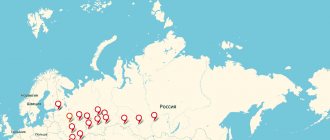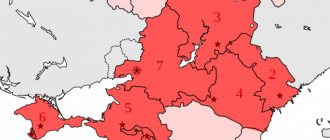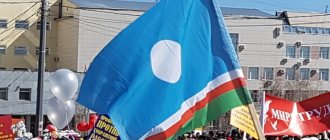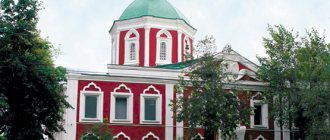General information about the Republic of Ingushetia
Distinctive features . Ingushetia is a small but proud Caucasian republic, which at one time made a lot of noise throughout the Soviet Union, and later on Russia. In terms of area, of all Russian regions, only Moscow and St. Petersburg are smaller than Ingushetia. In addition, it is the youngest republic in the Russian Federation (formed on June 2, 1992).
Ancestral towers against the backdrop of mountain landscapes are the calling card of Ingushetia
Another not entirely pleasant feature of Ingushetia is its extremely low investment rating. In this region, the lowest risk is environmental. And indeed, everything is in order with the environment here, which cannot be said about everything else. How can one not recall the recent war in the Caucasus, invasions of gangs from Georgia, and unresolved territorial issues with North Ossetia and Chechnya. Serious investors are simply afraid to invest their money here - they may not get it back. As a result, it ranks 84th in the ranking of regions by investment risk.
All this has an extremely unfavorable impact on the economy and social sphere. The republic has some of the highest rates of poverty and unemployment in Russia. At the same time, it has the highest birth rate. In general, this is an example of “third world” countries on the territory of the Russian Federation.
Geographical location. Ingushetia is comfortably located on the northern slopes of the Greater Caucasus Range and the small ridges adjacent to it. The republic is part of the North Caucasus Federal District and borders on North Ossetia in the west, the Chechen Republic in the east, and Georgia in the south.
On the map, Ingushetia appears to us as a rectangle with a length from north to south - 144 km, from west to east - 72 km. Despite the small area of the territory, the republic's topography is varied: there are steppe plains in the north and mountain ranges in the south, with picturesque gorges. The main river of Ignushetia is Sunzha, which flows into the Terek, one of the main rivers of the Caucasus.
Gorge of the Assa River - a tributary of the Sunzha
The highest mountain in Ingushetia is Shan (height 4451 m), located on the border with Georgia.
Population. As already mentioned, the birth rate in the republic is very high. In 2012 it was 22.6 people. per 1000 population. And due to the low mortality rate, the natural population increase was 18.9 per 1000 people. At the same time, the population of the republic has remained virtually unchanged since 2001. As of January 1, 2013, it amounted to 442,255 people. This suggests that people are leaving Ingushetia in search of a better life.
Most of the population lives in rural areas. At the same time, the population density is extremely high - 121.9 people. per sq. km. In terms of national composition, Ingush predominate (93.46%), Chechens are in second place (4.55%), and Russians are only in third place (0.78%). The share of the male population is only 44.7%.
The Ingush are one of the Vainakh peoples who form the basis of the population of the North Caucasus. Most of the Ingush are Muslims by religion.
Ingush people love and respect their national dances
Chechens live compactly in the east of the republic, on the border with Chechnya. These are mainly refugees who moved here in the 90s.
To summarize, we note that Ingushetia is a mono-ethnic national republic with a huge number of social problems and very low economic prospects. So it is unlikely that there will be anyone willing to move there from other regions, and if there are, they should think again before taking such a step.
Crime. In the ranking of regions by the number of crimes committed per thousand inhabitants, Ingushetia ranks third from the bottom, second only to Chechnya and Dagestan. It must be said that a low level of crime is typical for most Caucasian regions. This may seem strange. What is the reason for such calm in the republics, which until recently were “hot spots”? The reasons may be different.
On the one hand, the most criminally inclined people from the Caucasian republics are trying to move to large and promising cities in Russia, joining the ranks of national criminal groups. In addition, it should be noted that the leaders of the Caucasian republics are strictly establishing order in their regions. On the other hand, the reason may also be that the official bodies do not want to “wash dirty linen in public” and remain silent about the crimes being committed, preferring to solve all problems without unnecessary noise. In general, there can be many reasons, and most likely, each of them plays a role.
Meanwhile, reports about militants in Ingushetia appear in media feeds every now and then. Just a few years ago, there were frequent cases of them attacking the security agencies of the republic. The fight against militants and illegal armed groups does not subside in the republic to this day.
The unemployment rate in Ingushetia is the highest in the Russian Federation: 47.7%. To be fair, we note that just recently, in 2006, it was 64.86%. But it is too early to talk about any improvement in the situation, especially since in 2012 the number of employed people in various sectors of the economy decreased noticeably.
The average salary in Ingushetia is 17,000 rubles. By the end of 2012, its level also decreased, which indicates a serious crisis in the republic. And so, according to this parameter, Ingushetia looks even more or less respectable against the background of other Caucasian republics, especially Dagestan.
Property value. In Ingushetia, it is not apartments that are often sold, but entire houses, because the majority live in rural areas. A good house can be bought for 2-3 million rubles. As for apartments in Magas and Nazran, one-room apartments cost about a million rubles, two-room apartments - 1.5 - 2 million rubles, three-room apartments - 3 million rubles.
Nazran is the largest city in Ingushetia
The climate of Ingushetia is determined by its location on the ridges of the Caucasus. There are often strong winds here; in mountainous areas, winter comes very early - as early as September. Warm and humid summers are characterized by an average temperature of +7 ... +20°C. In Nazran in July it is slightly warmer than +26°C. In winter, the average temperature is about −7°C. The amount of precipitation depends on the location. On the northern slopes this figure reaches 1000 mm per year, on the southern slopes - only 400 mm per year.
What is a republic and its history
A republic is a state entity that is not endowed with the status of sovereignty, but has the right to establish its own state language, constitution, and republican symbols. They may have a certain degree of political and economic independence.
They often reflect their cultural, historical and social characteristics. The republic does not have the right to contradict federal laws and regulations, violate the integrity of the country or secede from it.
The first republics were formed after the revolution that took place in 1917. Basically they were independent entities, but some were parts of territories and regions. The Constitution, approved in 1936, significantly reduced the number of formations of autonomous republics. Some subjects separated from the RSFSR, but remained independent within the Soviet Union.
Other republics of the USSR also had autonomous units.
- Tajikistan was part of the Uzbek SSR for 5 years, but later became completely independent within the Union.
- In Georgia, Abkhazia and Adjara stood out, in Azerbaijan - Nakhichevan.
- The Republic of Moldova belonged to Ukraine, but after a 26-year union it separated, leaving some territories.
The last republic to emerge was Tuva (1961). Then, until 1990, the number of republics in the Union remained unchanged.
Then came the “parade of sovereignties” (1988-1991). Many republics declared their independence. Most of them have gained independence. They were transformed into the republics of Khakass, Karachay-Cherkess, Adygea, and Gorno-Altai regions. Ingushetia and Chechnya split, formerly forming a single republic.
Despite the acquired status of sovereignty by many republics, there is no talk of complete independence and separation from the territory of the Russian Federation . Although republics are called states in the Constitution of the Russian Federation, they do not have state sovereignty.
Subjects that are part of the Russian Federation cannot be granted sovereignty. Its bearer is only the multinational people of the country, and accordingly only the state itself. Sovereignty cannot have several levels, for example, at the level of the subject and the country itself.
Cities of the Republic of Ingushetia
Magas is the capital of the republic. This city was specially founded in 1995, and it received the status of the new capital of the republic in 2000. The population of Magas is very small - only 4,106 people. It is located just 4 km from Nazran, the former capital of Ingushetia. It is difficult to understand the logic of Ruslan Aushev, who planned to move the capital. According to him, this place used to be the capital of Alanya, destroyed by the Mongol-Tatars. Now this tiny town houses the authorities of the republic, as well as one of the buildings of the Ingush University.
Nazran is the largest city in Ingushetia (population: 102,471 people). Founded in 1781, this fortress became one of the most important strongholds of the Russian Empire in the North Caucasus. City status was obtained in 1967. Nazran is the main economic center of the republic. There is a light alloy plant, a concrete plant, a garment factory and a number of other small enterprises. The city leadership is trying to develop its infrastructure, repairing roads and eliminating landfills. So let's hope that the situation in the republic will gradually improve.
Fairytale world of mountains
The territory of Ingushetia stretches from south to north. And it is very clearly divided into two parts: plains and mountains. This is surprising, but these are actually two different worlds: here history and modernity practically do not intersect. The mountains are the historical heart of the republic, namely the Dzheirakhsky district, which is also known as “mountainous Ingushetia”.
And it is precisely this small region that is of particular interest, this kind of fabulous country, unprecedented for Russian people. Although, it would seem, we live in the same Russia. For a long time (during the Soviet period) people lived here in isolation, and practically no one visited these places. Well, maybe only rare hikers.
They restored contact with the outside world only in the nineties, by building a road through this area. And now it winds between gorges, hills and historical monuments. In mountainous Ingushetia there are now five rural settlements, in which there are quite a lot of villages. But most of them turned into real monuments: Egikhal, Erzi, Thaba-Erdy, Targim, Vovnushki. Just look at this tower complex!
These places preserve centuries-old Ingush history; it is a real open-air museum.
Municipal structure:[edit]
In the republic:
- 5 urban districts;
- 4 municipal districts: 36 rural settlements;
- 5 cities (Magas, Karabulak, Malgobek, Nazran, Sunzha);
- 117 rural settlements;
- 122 settlements.
Districts:[edit]
- — Dzheirakh MR (with Dzheirakh);*+
- — Malgobek MR (city of Malgobek);+
- — Nazran MR (city of Nazran);+
- — Sunzha MR (Sunzha);+
- - Karabulak GO (city of Karabulak);`
- — Malgobek GO (city of Malgobek);`+
- — Nazran GO (city of Nazran);`+
- — Sunzha GO (g Sunzha);`+
- — Magas GO (Mr. Magas).`+
- the symbol `
in the list of districts means an urban district; - the symbol +
in the list of districts means a district on the border of a subject; - the symbol *
in the list of areas means a border area.
Urban districts:[edit]
- - City of Magas;
- — Karabulak city;
- — City of Malgobek;
- — City of Nazran;
- - City of Sunzha.
Table of municipalities[edit]
- GO - urban district;
- MR - municipal district;
- GPMR - urban settlement in the region;
- SPMR - rural settlement in the region;
- MO - municipal entity;
Table of settlements:[edit]
- G - city;
- PGT - urban-type settlement;
- SNP - rural locality;
- NP - populated area.
Legal status
Numerous interethnic clashes that took place in the post-Soviet territory forced the Russian leadership to change its approach to relations between the regions and the center and introduce a system of federal treaties, which became the legal basis determining the status of the republics in the Russian Federation.
In a modern federation, republics are legal democratic states, and their structure is determined by the Constitution of Russia and the republic itself. The powers between the republics and the federal center, as well as interbudgetary relations and taxes, are regulated by relevant laws and federal treaties. For example, within the framework of federal agreements, decisions are made on the number of hours that schools can devote to teaching the national language of the republic.
Deportation of the peoples of the USSR
The legal status of the republics of the Russian Federation has changed throughout their history. The most significant blow to the autonomy of the peoples of the Caucasus was dealt after the end of Nazi occupation and the return of Soviet power to the region.
In 1944, the Chechen-Ingush Republic was abolished, the national autonomy of the Balkars and Karachais was liquidated, and the representatives of the peoples themselves were deported to Siberia and Central Asia, where they lived until 1957, when they were rehabilitated.
However, not only the peoples of the North Caucasus were deported, but also the Crimean Tatars, who were also extrajudicially repressed.
Sights of the region
Ingushetia is a fairly young republic, which is confirmed by the history of its cities. However, this land is ancient and people lived here centuries ago. If you drive through villages and cities, you can see a lot of interesting things.
For example, near Magas there is “Acham-Boarz” - a settlement where tourists try to go on excursions. Here, in the capital, is the tallest Ingush building, the Tower of Concord.
And in Nazran a Memorial of Memory and Glory was erected. It was erected in due time so that residents and guests of the republic would remember the heroes of the wars in which Russia was forced to take part, and the people who fell victims of the repressions of 1944. In addition, on the territory of the city there is the Borga-Kash mausoleum, built in the 15th century, and you can also see an ancient Russian fortress.
Those who come to Karabulak can visit the Republican Museum of Fine Arts. In the same city there is a church of the icon of the Kazan Mother of God - this is one of the Orthodox churches that exist in very small numbers in Ingushetia. But the main decoration of the cities of Ingushetia is, of course, nature. It is precisely this that serves as the background against which all five cities become a real necklace of a young, but such a promising region.
State and legal characteristics of entities
Almost every subject is a state , this is evidenced by the presence of legislative power and the ability to independently adopt a constitution that determines further organization on the territory of education. However, all legislative acts should not differ from the provisions of the Constitution of the Russian Federation. Authorities in the subjects are formed as a result of elections among the peoples and nationalities living on their territory. And also the republic is the guarantor of the statehood of all nationalities living there.
One of the signs of statehood is the presence of its own territories and borders, which are considered open between all entities on the territory of the Russian Federation. The adopted legislation of a subject is valid only within its territory. Each entity has its own flag, its own coat of arms and its own anthem and, naturally, its own capital. And also, each republic has its own president, Supreme Court, prosecutor, who reports to the Prosecutor General of Russia, and its own Constitutional Court.
After the USSR
Not all republics of the Russian Federation at the time of the collapse of the Soviet Union had any intention of continuing membership in the federation. Some, such as the Chechen-Ingush Republic, decided to declare sovereignty.
However, the Ingush did not support the intentions of the Chechens and left the Chechen-Ingush SSR, creating their own Ingush Republic, which headed for loyalty to Russia. This is not what the leadership of the Chechen Republic did, which decided to completely separate itself from Russia even at the cost of significant losses. This approach provoked a protracted conflict and ultimately led to the Chechen War.
The importance of the republics within Russia
The constituent entities of the Russian Federation occupy a fourth of the territory of the Russian Federation and are home to more than 160 nationalities. Throughout history, the existence of entities has been closely connected with each other and with other subjects of Russia. Their role is very important for the Russian Federation. In the northern part of the country, enterprises for the extraction of gas, oil, timber and natural resources are well developed. Sakha (Yakutia) is known for its deposits of precious metals and diamonds. The formations of central Russia are known for their agricultural lands. In the territories of Bashkiria and Tataria, oil is produced in large quantities, which greatly distinguishes them in terms of economic growth.
The southern republics of the country are known for their resorts and hospitals. Crimea, the most subsidized region, has now been added to them. The subjects of Russia, previously, were not very popular and were explored by tourists from foreign countries. Thanks to the development of tourism in the country, foreign guests have great opportunities to get acquainted with the constituent entities of Russia. And also, this is facilitated by the holding of world-scale sporting competitions.
Below we provide a list of Russian republics and their capitals:
- Republic of Komi—Syktyvkar;
- Mordovia—Saransk;
- Republic of Sakha (Yakutia)—Yakutsk;
- North Ossetia (Alania)—Vladikavkaz;
- Tyva-Kyzyl;
- Chechen Republic—Grozny;
- Chuvashia—Cheboksary;
- Khakassia-Abakan;
- Udmurtia—Izhevsk;
- Dagestan—Makhachkala.
12 more republics:
- Ingushetia-Magas;
- Bashkortostan—Ufa;
- Altai—Gorno-Altaisk;
- Adygea-Maykop;
- Kabardino-Balkaria—Nalchik;
- Kalmykia—Elista;
- Karachay-Cherkess Republic—Cherkessk;
- Tatarstan—Kazan;
- Mari El-Yoshkar-Ola;
- Karelia—Petrozavodsk;
- Buryatia—Ulan-Ude;
- Republic of Crimea—Simferopol.
Continuation of education
After the well-known political events of the early nineties of the last century, when the USSR ceased to exist and Russia became an independent state, the republics within the Russian Federation began to reform . This was accomplished due to the fact that the former autonomies and regions became owners of greater independence.
Thus, in the mid-1990s, each subject achieved sovereignty, and a number of transformations took place in the autonomous regions. Thus, a number of republics in the Caucasus and Altai were reorganized. The division of Checheno-Ingushetia led to the creation of two sovereign entities. However, there was never talk of secession from the Russian Federation. Each entity that is part of the Russian Federation has national holidays that are widely celebrated by all nationalities, according to their traditions.
